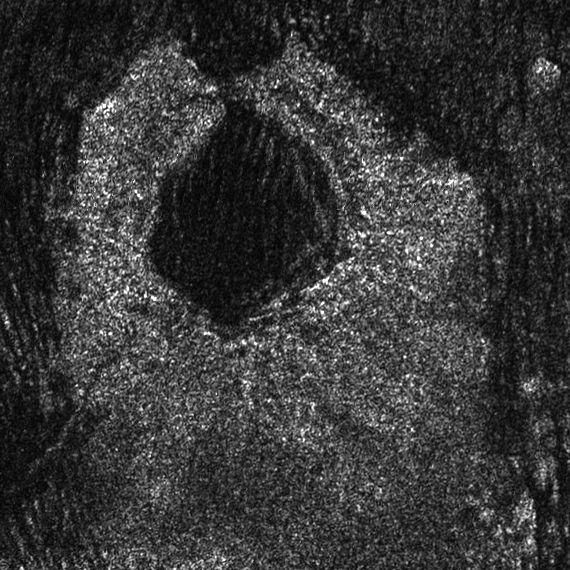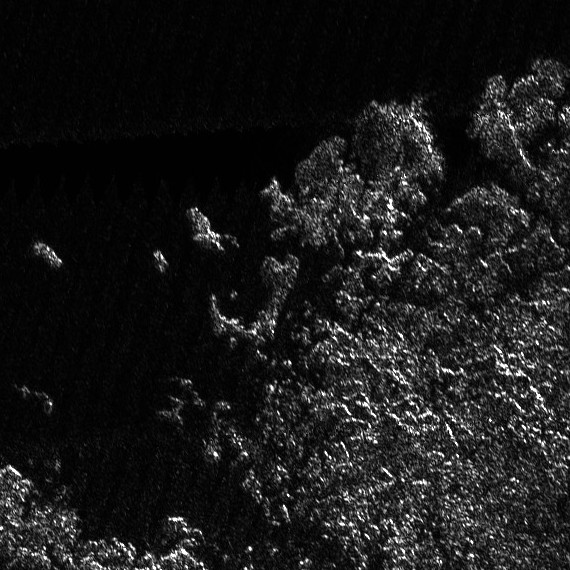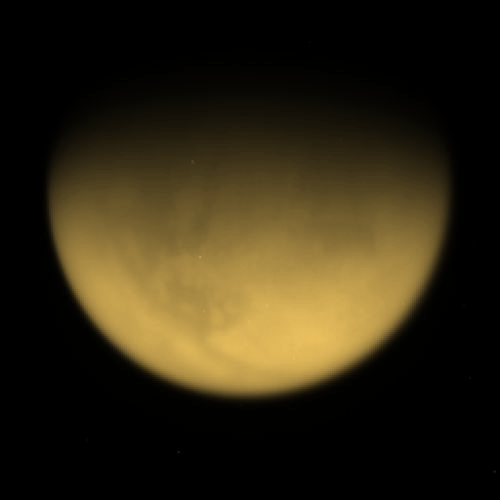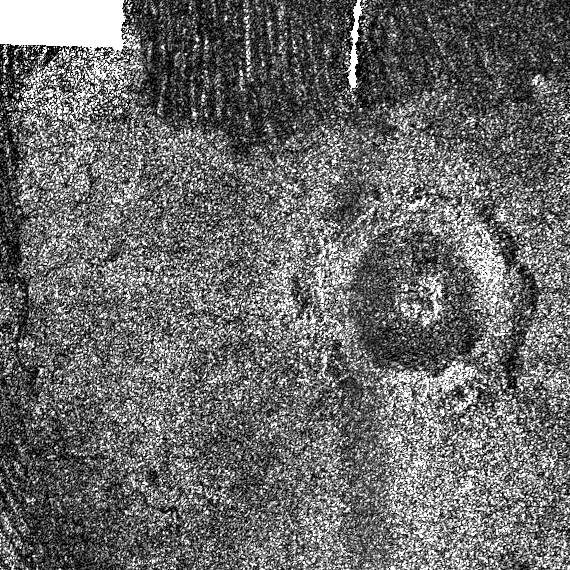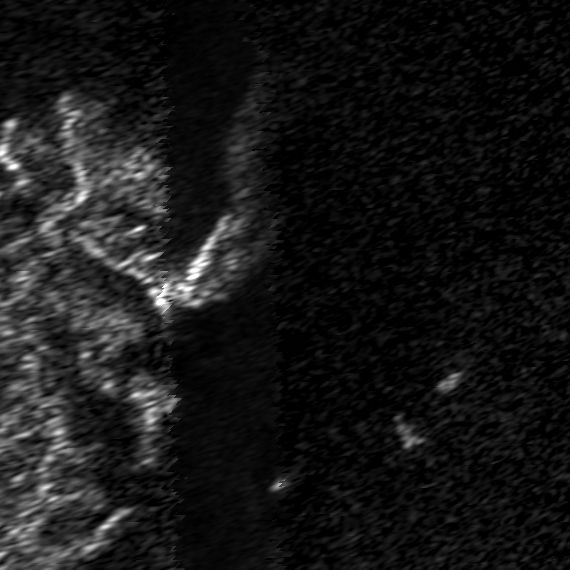Titan News 2024
October 27, 2024: A Deep Layer Of Methane Clathrate Explaining Relatively Shallow Impact Craters On Titan ?
A new study entitled "Rapid Impact Crater Relaxation Caused by an Insulating Methane Clathrate Crust on Titan", published by the American Astronomical Society on September 30, 2024 and proposed by a team of researchers mobilizing Lauren R. Schurmeier and Gwendolyn E. Brouwer in particular reveals that the relatively limited depth of the impact craters of Titan may be related to the action of a relatively deep layer of methane clathrate ice. So far, planetologists have been in a position to identify only 90 craters on Saturn's largest moon. Most craters may not be the outcome of a meteoritic impact or a cometary impact. The deep and thick atmosphere of Titan implies resurfacing events or strong erosional processes. That's why a particularly limited amount of craters has been identified on the surface of that intriguing world. The planetologists have performed a comparison between the craters of Titan and the craters of the giant moon of Jupiter Ganymede. Thus, they managed to determine that the presumed impact craters of Titan are hundreds of meters shallower than expected on the basis of similar-sized craters on the largest moon in the Solar System. How can we explain that difference ?
Several processes have been put forward to account for the rapid evolution of the craters of the Opaque Moon. In the harsh environment of Titan where the air is particularly dense at sea level, winds can be relatively strong in the low or middle latitudes and erode the impact craters, the cryovolcanic craters or the calderas. The winds can displace the exotic sand that will tend to fill the craters. Therefore, the appearance of any crater will tend to change relatively quickly over geological time scales. Some craters of Titan may not be discernable due to relatively strong erosional processes or due to the migration of sand that can partially or completely fill any impact crater or cryovolcanic crater. Rainfall events mobilizing methane or ethane can engender transient rivers that can invade or fill the craters implying relatively strong erosional processes like rainfall events mobilizing water on Earth. Topographic relaxation engendered by insulating sand infill can also be considered to account for the change in the appearance of the craters of that giant moon of Saturn. The team Of Lauren R. Schurmeier proposes another potential mechanism to account for the alteration or the change in the appearance of the Titanian craters.
July 17, 2024: Bistatic Radar Experiments Allow Us To Evaluate The Roughness And The Composition Of The Pools Found In The North Polar Region Of Titan
A new study entitled "Surface properties of the seas of Titan as revealed by Cassini mission bistatic radar experiments", proposed by a team of researchers involving Valerio Poggiali, Alexander Hayes and Philip Nicholson and published in Nature Communications on July 16, 2024 reveals that bistatic radar experiments involving the data acquired from the Cassini spacecraft and from a receiving antenna on Earth regarding the land of lakes and seas in the north polar region of Titan bring significant clues upon the nature and the roughness of the pools in the area. Planetologists had already determined that the lakes and seas of Saturn's largest moon appeared remarkably quiet or smooth during the long mission of the Cassini probe in the Saturn System from 2004 to 2017. The composition and the roughness of the lake or sea can vary depending on the latitude, the area or the season. The new research work reveals or suggests a difference in the composition of the liquid between the rivers, the estuaries, the lakes or the seas found in the north polar region of the giant moon. Several types of molecules or elements can be encountered in those exotic pools.
The Cassini-Huygens mission in the Saturn System has allowed us to collect a huge amount of information regarding Saturn, Titan and the other major moons of the Gas Giant. The Huygens probe had revealed a diverse landscape with bright hills, a brown or dark plain and dark channels that may represent drainage channels related to meteorological phenomena. The radar views as well as the infrared or near-infrared views obtained from the Cassini spacecraft have clearly revealed the presence of lakes, seas or rivers in the high latitudes of each hemisphere of Titan. In the harsh environment of that intriguing world, methane, ethane or propane can be found in their liquid form on the surface. Prior to the Cassini-Huygens mission in the Saturn System, planetologists had anticipated the potential presence of lakes, seas or oceans dominated by methane or ethane. Some researchers had imagined that the relatively dark areas which mark a sharp contrast with relatively bright areas in the low or middle latitudes could represent seas or oceans of methane or ethane. The radar views have clearly shown that those relatively dark areas are in fact dominated by linear and parallel dunes that extend over long distances.
June 21, 2024: A Significant Role Of Waves In The Shape Of The Coasts In The Lakes Or Seas Of Titan ?
A new research work entitled "Signatures of wave erosion in Titan's coasts", published in Science Advances on June 19, 2024 and proposed by a team involving Taylor Perron and Rose Palermo reveals the potential influence of waves in the erosion and in the shape of the coasts of the lakes or seas on Saturn's largest moon Titan. Titan is the only extraterrestrial world known to harbor stable pools of liquid in the Solar System. Lakes and seas have been confirmed on the Opaque Moon as soon as 2007 thanks to images acquired from the Cassini orbiter. The first stable pool of liquids was identified in the high latitudes of the southern hemisphere. That pool is known as Ontario Lacus. Later, we found a region of lakes and seas in the high latitudes of the northern hemisphere. Kraken Mare, Ligeia Mare and Punga Mare are the major pools of liquids found in the northern hemisphere. The lakes, seas and rivers of Titan are thought to be composed of a mixture of methane and ethane. The composition of the lakes or seas must be influenced by seasonal factors and regional factors. The dynamics of the lakes, seas and rivers in that harsh environment is a major topic of research.
Thanks to the huge amount of data captured with the eyes of the Cassini orbiter in particular, we have been in a position to evaluate the potential dynamics of the lakes or seas of Titan. Most planetologists advance that the lakes or seas of Titan may be particularly flat or smooth on the basis of radar data in particular. Some researchers have advanced that some lakes or seas of that intriguing world may be almost as smooth as a mirror. Does it mean that there is a thin layer of viscous hydrocarbons above the liquid ? Are our interpretations of the radar signals in line with reality ? The new study proposed by MIT geologists suggests that the coasts of the major seas of Titan may have been shaped by waves. In other words, waves must have played a significant role in the erosional process of the coasts of the lakes or seas. That conclusion was made possible thanks to simulations that are in line with what we had suspected on the basis of remote images that suggest indirect and conflicting signs of wave activity. The first step in the research work was to model the ways in which a lake can erode on our planet. The model regarding the lakes of the Earth was then applied to the major pools of Titan in order to determine what type of erosion could have generated the shorelines observed in the Cassini views.
March 13, 2024: High-Resolution Spectra Of Titan Suggest The Presence Of C3 In Its Atmosphere In Particular
A new research work entitled "A study of very high resolution visible spectra of Titan: Line characterisation in visible CH4 bands and the search for C3", published in Planetary and Space Science in January 2024 and proposed by a team involving Rafael Rianco-Silva suggests the presence of C3 in the atmosphere of Titan on the basis of high-resolution spectra in visible CH4 bands. The high-resolution visible spectra of Saturn's largest moon were obtained from Earth with VLT-UVES. The planetologists mobilized and analyzed an empirical high resolution list of methane absorption features at a high resolution between 5250 A and 6180 A. A major goal of the study was to identify the presence of C3 in the opaque atmosphere of the giant moon. The presence of C3 in the Titanian atmosphere had been predicted but never detected. The researchers tried to find it at its 4051 A band. The outcome of the team is consistent with the presence of the tricarbon molecule (C3) in the upper atmosphere of the Orange Moon, with a column density of 10^13 cm-2. The research work based on high-resolution visible spectroscopy allows astronomers to deepen their knowledge regarding atmospheres in which CH4 is the main visible molecular absorber. They are in a position to analyze the CH4 optical properties and the chemistry of that soup of molecules or elements.
The complex atmosphere of Titan is likely to tell us a lot regarding the atmosphere of exoplanets containing methane like Uranus or Neptune for instance. The atmosphere of Saturn's largest moon is dominated by molecular nitrogen like the atmosphere of the Earth or like the atmosphere of the Dwarf Planet Pluto as well. To a certain extent, the atmosphere of Titan may look like the atmosphere of the Early Earth. A major difference between the atmosphere of Titan and the atmosphere of the Earth is related to methane. The second most abundant gas in the atmosphere of Titan is methane rather than oxygen which is absent or almost absent in its harsh atmosphere. The atmosphere of the Earth contains around 21 percent of oxygen thanks to our biosphere. The environmental configuration is very different on Titan. The level of energy received from the Sun at the level of Titan is particularly low so that the environmental temperature at the level of the surface is around -179 degrees Celsius, -290 degrees Fahrenheit or 94 Kelvin. That's a configuration in which water can only appear in its solid form on the surface. Oxygen elements will tend to be trapped within the water molecules or in water ice.
February 15, 2024: Carbon Migration Into The Presumed Subsurface Ocean Of Titan Via Impact Cratering May Be Too Limited For The Development Of Life
A new study entitled "Organic Input to Titan's Subsurface Ocean Through Impact Cratering", proposed by a team led by Catherine Neish and published in the journal Astrobiology on February 2, 2024 suggests that the amount of organics and glycine in particular migrating from the surface to the hypothetical subsurface ocean of Titan under the action of impact cratering appears too limited for the emergence and the development of life. The planetologists assumed that impact craters engender melt deposits containing liquid water. The mean density of the material is higher than the mean density of the icy crust so that the material rich in organics and rich in glycine in particular will tend to migrate toward the presumed subsurface ocean rich in liquid water. The team was in a position to evaluate the amount of organic molecules that could be injected into the subsurface liquid layer. The specialists mobilized known yields for HCN (Hydrogen cyanide) and the haze hydrolysis of the giant moon to determine the amount of glycine generated in the melt lenses and obtained a range of potential flux rates of glycine from the ground to the presumed subsurface ocean.
The range of possible flux rates of glycine appears to be between 0 and 10^11 mol/Gyr for HCN hydrolysis and appears to be between 0 and 10^14 mol/Gyr for haze hydrolysis. These fluxes imply an upper limit for biomass productivity of about 10^3 kg C/year on the basis of a glycine fermentation metabolism. This upper limit appears clearly low for the potential emergence or development of life. This upper limit for biomass productivity is even significantly lower than recent evaluations of the hypothetical biomass production taking shape in the presumed subsurface ocean of the tiny moon Enceladus. Yet, Titan is regarded as a world rich in organics and hydrocarbons but the concentration of molecules rich in carbon elements inside the hypothetical subsurface ocean of the Opaque Moon may be too limited for the emergence or the development of any lifeform based on liquid water and carbon. However, the planetologists of the research work focused their attention on the influence of impact cratering upon the amount of organics transferred from the surface to the presumed subsurface ocean. They don't consider other potential sources of organics or hydrocarbons that can fuel that hypothetical ocean.
January 9, 2024: The Famous "Magic Islands" Of Titan May Represent Relatively Porous Organic Glaciers According To A New Study
A new research work entitled "The Fate of Simple Organics on Titan's Surface: A Theoretical Perspective", published in Geophysical Research Letters on January 4, 2024 and proposed by a team of researchers involving Xinting Yu, Yue Yu, Julia Garver, Xi Zhang and Patricia McGuiggan suggests that the famous "Magic Islands" of Titan may represent relatively porous organic glaciers. The Magic Islands had been identified in 2014 thanks to radar data taken from the Cassini spacecraft during its orbital dance in the system of Saturn and its numerous moons. In the land of lakes and seas found in the high latitudes of the northern hemisphere of Saturn's largest moon, transient islands seem to be present from time to time. During the long mission of the Cassini orbiter in the Saturn System, from 2004 to 2017, we had obtained a multitude of radar images and we have been in a position to perform an analytical work regarding the evolution of the lakes, seas or rivers found in the high latitudes of the Opaque Moon. In Ligeia Mare or Kraken Mare, new bright patches had appeared inside the pools and they had progressively vanished in just a few weeks.
What do those enigmatic bright patches represent ? Are they really islands ? Do they represent an area of strong waves ? Do they represent a field of bubbles related to cryovolcanic features ? Are they transient icebergs ? Are they related to a biological system within the pool ? The debate is far from being over and several hypotheses can be put forward. In the new study proposed by UTSA professor Xinting Yu and her collaborators, the hypothesis that the Magic Islands could in fact represent relatively porous organic glaciers is rigorously considered. The floating chunks of porous, icy organic solids may be closely related to atmospheric phenomena. There is a complex chemistry in the atmosphere of that giant moon. The haze of the atmosphere is closely related to the light from the Sun. Ultraviolet radiations engender various chemical reactions in the upper atmosphere. The atmosphere of Titan is in fact a soup of elements, molecules or radicals where relatively complex molecules can emerge and fall toward the surface. The atmosphere of that orange world is clearly remarkable because it may look like the atmosphere of the Early Earth. Like the atmosphere of the Blue Planet, the atmosphere of Titan is dominated by molecular nitrogen.
Titan News 2023
Titan News 2022
Titan News 2021
Titan News 2020
Titan News 2019
Titan News 2018
Titan News 2017
Titan News 2016
Titan News 2015
Titan News 2014
Titan News 2013
Titan News 2012
Titan News 2011
Titan News 2010
Titan News 2009
Titan News 2008
Titan News 2007
Titan News 2006
Titan News 2004, 2005
Back to Main Page
